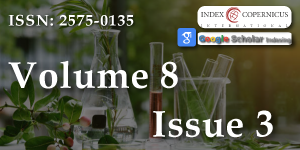Inventorization and Exploration of Floral Diversity in Metropolitan Cities of India for Their Suitability in Floriculture of Kashmir
Main Article Content
Abstract
Floriculture is the branch of horticulture that deals with the cultivation and management of flowers and ornamental plants and has blossomed into commercial activity with considerable growth and a useful crop diversification option, particularly for small farmers over the past three decades. It is a global industry with significant economic, social, and aesthetic values. Globally 171 countries practice floriculture. India occupies 51st position in terms of exports and contributes Rs. 455 crores which is 0.06% of global trade.
The present study was carried out during the College on Wheels project organized by the Higher Education Council, Union Territory of Jammu & Kashmir, and was aimed to explore the floral and ornamental plant diversity of major metropolitan cities like Delhi, Goa, Bengaluru, Mumbai, etc. of India for evaluating their suitability for introduction in floriculture of Union Territory of Jammu & Kashmir.
The floral and ornamental plant species were explored, photographed, evaluated, identified, and inventorised. A total of 51 species belonging to 23 different families of floral and ornamental plants were explored and evaluated in terms of parameters like climate, soil type, photoperiod requirements, watering needs, and maintenance requirements for their cultivation. It was found that some of the explored species of ornamental plants were already introduced into the Union Territory of Jammu and Kashmir because the parameters for the successful growth and thriving of these species match with the existing climatic and other conditions in the Union Territory of Jammu and Kashmir. Besides, the climatic and other requirements of some of the explored species were found in conformity with the climatic and other parameters available in the Union Territory of J&K for the successful establishment and growth of plants. Thus, there is an urgent need to introduce these explored species into the region to enhance the floral diversity of ornamental plants, beautify the landscape, and promote tourism and the generation of better livelihood. The Department of Floriculture should take a lead role in this direction to import these floral and ornamental plant specimens from pan India.
Article Details
Copyright (c) 2024 Shakoor SA, et al.

This work is licensed under a Creative Commons Attribution 4.0 International License.
Saiema A, Wani MA, Singh H. Economic viability of floriculture in Kashmir Himalayas: A geographical study of Greater Srinagar. J Hum Soc Sci. 2017;22:66-71. Available from: https://iosrjournals.org/iosr-jhss/papers/Vol.%2022%20Issue10/Version-3/J2210036671.pdf
Paswan MK. Marketing of flowers: A case study of Bansphatak flower market. Department of Agricultural Economics, BHU: Varanasi. 2015.
Desh Raj. Floriculture at a glance. In: Importance of ornamental horticulture. Ludhiana: Kalyani Publishers; 2016;17.
Raina V, Nain MS, Sharma R, Khajuria S, Kumbhare NV, Bakshi M. Floriculture in Jammu and Kashmir: Performance, problems and prospects. J Pharmacogn Phytochem. 2007;1:287-293. Available from: https://www.phytojournal.com/special-issue/2017.v6.i6S.2584/floriculture-in-jammu-and-kashmir-performance-problems-and-prospects
Dar AA, Bhat MA. Marketing challenges of horticulture sector in Jammu and Kashmir: A case study of district Pulwama. Nat J Multidiscip Res Dev. 2018;3(1):1144-1146. Available from: https://newresearchjournal.com/assets/archives/2018/vol3issue1/3-1-337-744.pdf
Chawla SL, Patil S, Ahlawat TR, Agnihotri R. Present status, constraints and future potential of floriculture in India. In: Patel NL, Chawla SL, Ahlawat TR, editors. Commercial Horticulture. New Delhi: New India Publishing Agency; 2016. p. 29-38. Available from: https://www.researchgate.net/publication/311910156_Present_Status_Constraints_and_Future_Potential_of_Floriculture_in_India
Datta SK. Present status of research on floriculture in India. Int J Life Sci. 2019;8:71-93. Available from: http://dx.doi.org/10.5958/2319-1198.2019.00006.X
Choudhary ML. Flowers for trade. In: Sheela VL, editor. Flowers for Trade. Vol. 10. New Delhi: New India Publishing Agency; 2008. Available from: https://books.google.co.in/books/about/Flowers_for_Trade.html?id=RGa2VeA8HiMC&redir_esc=y
Zeerak NA, Wani SA. Diversity of irises from Kashmir Himalaya. J Ornamental Hortic. 2007;10(2):115-118. Available from: https://www.indianjournals.com/ijor.aspx?target=ijor:joh&volume=10&issue=2&article=009
Khuroo AA, Irfan R, Reshi Z, Wafai BA. The alien flora of Kashmir Himalayas. Biol Invasions. 2007;9:269-292. Available from: https://link.springer.com/article/10.1007/s10530-006-9032-6
Gupta SK. Floriculture scenario in district Udhampur, Jammu & Kashmir. J Agroecol Nat Resour Manag. 2019;6:207-209. Available from: https://krishisanskriti.org/vol_image/13Mar2020090355z02%20%20%20%20Sanjeev%20Kumar%20Gupta%20%20%20%20%20207-209.pdf
Tropicos.org. Missouri Botanical Garden. 14 Nov 2024. Available from: https://tropicos.org
The Plant List. Version 1. Published on the Internet. Available from: http://www.theplantlist.org/
WFO. World Flora Online. Published on the Internet. Available from: http://www.worldfloraonline.org
eFloraofIndia (BSI). Database of plants of Indian Subcontinent. Available from: https://efloraofindia.com/
Champion H, Seth SK. A revised survey of forest types of India. New Delhi: Government of India Press; 1968. Available from: https://books.google.co.in/books/about/A_Revised_Survey_of_the_Forest_Types_of.html?id=ZdMsAQAAMAAJ&redir_esc=y
Beaulieu JM, Smith S, Leitch IJ. On the tempo of genome size evolution in angiosperms. J Botany. 2010;2010:989152. Available from: https://doi.org/10.1155/2010/989152
Sheikh MQ, Bhat ZA, Siddique AMM, Singh KP, Saha TN. Present status and prospects of floriculture in Jammu and Kashmir. ICAR-DFR Bulletin No. 13. ICAR-Directorate of Floricultural Research, College of Agriculture Campus, Shivajinagar, Pune - 411 005 (Maharashtra), India; 2015.
Sethi SS, Vinoj V. Urbanization and regional climate change-linked warming of Indian cities. Nat Cities. 2024;1:402-405. Available from: https://www.nature.com/articles/s44284-024-00074-0

